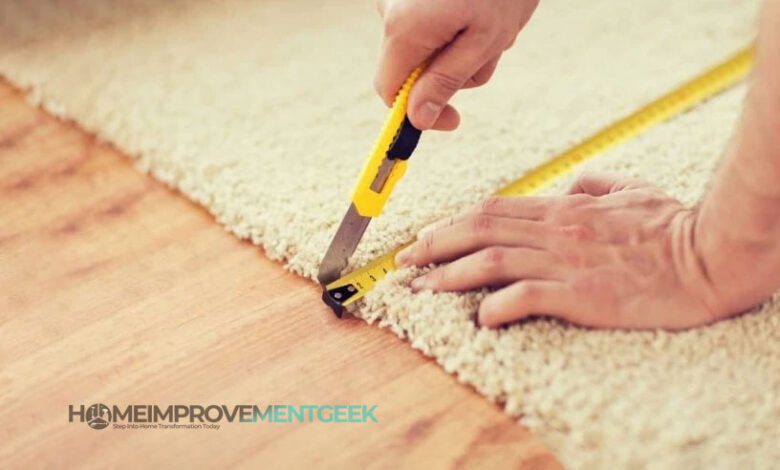How to Cut a Rug Without It Fraying: DIY Tips for a Clean Finish

Have you ever found the perfect rug that is just a little too big for your space? Or maybe an old rug has seen better days and you want to give it new life by cutting it down to a more modern shape or size. Customizing a rug to perfectly fit your home can give rooms a pulled-together, designer look.
But cutting a rug is tricky business. If you don’t do it properly, you’ll likely end up with a frayed, ragged edge that unravels over time. Not cute! However, with some planning and the right tools, you can trim a rug without any fraying whatsoever.
Rugs are expensive! Dropping big bucks on a custom-sized rug only to have it meet an untimely end thanks to loose, fraying edges is heartbreaking. But armed with my handy tips on how to cut a rug without it fraying, you can customize affordable rugs to create one-of-a-kind pieces that suit your home perfectly.
Follow these DIY rug trimming techniques, and no one will ever guess your bouclé botanical beauties started out as oversized odds and ends!
Trimming a rug without creating a frayed mess is absolutely possible. While it does require careful prep and the right tools, as long as you accurately mark cut lines, mind edge bindings, utilize specialty blades, and properly finish trimmed edges, you can cut rugs to custom sizes with clean, professional results.
Measure and Mark Desired Cut Lines
When working with a large rug you intend to cut down to size, the very first step is measuring and accurately marking the dimensions you want the finished rug to be.
Planning Guidelines
- Decide on ideal dimensions based on where rug will be used
- Account for optimal floor coverage relative to furnishings
- Allow ample rug pad overlap if using one
Measuring Essentials
Accurately measuring the rug and marking perfect cut lines is crucial for achieving an even, non-fraying edge. You’ll need:
- Tape measure. A long, standard metal tape measure is best.
- Marking tool. Use chalk, pencil, or removable marker.
- Straight edge (yardstick, level, wood trim piece). Ensures straight lines.
Pro Tip:
Rather than eyeballing it, use your straight edge guiding tool to keep tape measure perfectly straight while marking lines.
Marking Cut Lines
- Starting at one corner of the rug, place tape measure along one edge, perpendicular to corner.
- Keeping straight edge aligned with tape measure to maintain straight lines, mark cut line at desired dimension.
- Repeat process on adjoining edge, again utilizing your straight edge guide for accuracy.
- Connect markings from adjacent edges to complete cut line box. Double check all measurements!
Accurately measuring and marking the exact cutting lines is a critical first step to cleanly cutting a rug without fraying. Rushing this foundational process can sabotage the end visual result!
Common Rug Measuring Mistakes
- Not allowing enough overlap for rug pad
- Forgetting to account for rug thickness
- Uneven lines from eyeballing instead of using guides
Mind the Edge Binding
Another key preparatory step to cutting a rug without creating a frayed mess is dealing with any edge binding. Most rug edges have some type of material binding, trim, or edge finish that must be addressed before cutting the rug itself.

Thick canvas edge binding must be removed before cutting rug
Why It Matters
- Creates visible edge inside cut lines if left in place
- Prevents clean rug cutting
- Can lead to uneven fraying or tears
Common rug edge treatments include:
- Canvas binding – thickly woven edging for durability
- Serged edges – overlook stitch helps prevent fraying
- Whipped ends – wrapped yarn helps secure rug shape
- Wool fringes – decorative and functional
To Bind or Not to Bind?
For most rug materials, removing any edge binding altogether yields the cleanest cut. However:
- Natural fiber rugs (jute, sisal) fray easily without bound edges
- Small remnants may not need rebinding if secured underneath furniture
- Rebinding after cutting maintains a finished look
Removing Edge Binding
- Carefully cut through edge material using rotary cutter, razor, or sharp scissors
- If needed, trim off any binding remnants using a box cutter flush with rug edge
- Cleanly cut rug without impediments from thick binding edges
By properly removing or cutting through rug edge bindings before cutting the main rug itself, you ensure the ability to achieve a clean, straight finished cut.
Cut Off Excess Length and Width
Now comes the fun part – time to do the actual rug cutting! With measurements made and edge bindings cleared away, you have the challenging but gratifying task of cutting the rug down to your custom dimensions.

Electric shears make cutting off length and width simple!
Without the right tools, cutting through rug fibers can be tough going and increase the likelihood of errors. For clean DIY rug cutting, specialized tools are a must.
Recommended Cutting Tools
- Carpet shears – electric or manual options
- Rotary cutter – sharp circular blade
- Carpet cutter – slots along solid weighted base
- Straight edge – thick yardstick or level
- Cutting mat – self healing surface protects floors
Technique Tips
- Keep tools directly on marked guideline – don’t eyeball it
- Use straight edge to maintain straight cuts
- Take long strokes using blade edge as guide
- Let tool do the work – no need to apply lots of pressure
- Stand rug on end or fold over to access both sides
Follow your cut lines marked earlier, utilizing your selected cutting implements to trim off any excess length and width. The key is working slowly and methodically for maximum control. Rushing increases the chance of veering off course!
Watch Out For…
- Curved cut lines – stick with straight lines only
- Cutting through rug backing – can lead to buckling or tears
- Applying too much shear pressure – leads to uneven cuts
By carefully following marked guidelines and using specialty rug cutting blades, you’ll achieve a custom cut area rug with straight edges and no fraying in sight!
Reattach Edge Bindings
Once happy with your freshly cut rug dimensions, reattaching some form of edge binding along the new perimeter completes the custom rug facelift. Unless you’re leaving small remnant pieces exposed under furniture legs, binding the edges helps reinforce shape, prevents loose fringe-type unraveling, and maintains an overall finished look.
When to Bind Edges
- Any rug remnant not secured under furnishings
- Materials prone to fraying – jute, wool, natural fibers
- Larger cut-down rugs used standalone
- Wanting a polished bound edge final appearance
You have creative options when it comes to rebinding your custom cut rug! Consider materials easily worked with at home:
DIY Rebinding Options
- Duck tape – strongest and easiest binding method
- Bias tape – must be tightly stretched
- Twine – for casual braided rugs
- Hot glue – affix pre-made carpet binding tape
Technique Guidelines
- Thoroughly clean rug edge first – removes debris interfering with adhesion
- For hot glue, carefully apply to underside of binding then quickly smooth onto rug edge
- For tape methods, flatten along edge, leaving equal parts tape on top and bottom rug surfaces
Achieving straight, secure edges when rebinding rugs does have a learning curve. An alternative is having a rug professional rebind edges with canvas binding strips using a special serging sewing machine technique.
Consider Professional Help
For rugs made from specialty materials like delicate silks or intricate needlepoints, or if dealing with challenging shapes like octagons or circles, consider handing cutting over to a seasoned pro.
Rug binding services at flooring shops or even mobile services specializing in binding carpet and rugs have specialty equipment and expert knowledge of fiber characteristics.
Professional Binding Benefits
- Durable edges secured via strong machine stitching
- Consistent tension and stitch settings
- Less home technique learning curve
- Ability to handle all manner of rug materials and shapes
- Protecting valuable heirloom or investment rug pieces
Yes, utilizing professional services does involve additional cost and production time. However for difficult materials or absolutely essential perfection, it can well be worth it!
At the end of the day, assess your available tools, knowledge level, rug’s value, and end use space. For casual spaces like basements or lake houses, DIY binding likely suffices. But heirloom silk creations headed for the formal living room merit extra TLC!
Carpet Cutting Tools For Precision
Up your rug cutting game by using tools actually intended for cutting carpet. Designed for powering through dense carpet fibers and padding with ease, they also make DIY rug trimming a cinch.
Specialized carpet cutting tools differ from standard scissors or utility knives. Thanks to ultra sharp hot-forged steel blades, handy sight guides, and weighted bases providing needed leverage, you get more control, straight edges, and cleaner cuts.
Helpful Carpet Cutting Tools
- Carpet Shears – Long handles give leverage to blade tackles thick carpeting in single pass. Some electric options available too!
- Carpenter Square – The iconic carpenter’s woodworking square helps you cut perfect 90° corners and straight edges on carpet.
- Knee Kicker – This rug binding assistant tool features a padded plate for kicking carpet into place for tight seam alignments. No more cramping hands trying to pull heavy rugs!
- Seam Iron – Specifically designed to securely meld rug padding, carpet backing, and binding tapes together via heat activated glue strips. Prevents fails with too heavy or cool standard irons.
Investing in a few key carpet installer and rug binding tools goes a long way towards achieving expert looking results. The handy aids help get perfect measurements, cleanly cut through rug fibers like butter, and create secure bindings that withstand wear and tear over time.
Cut Rugs To Fit Small Spaces
Sometimes fully covering a floor with wall-to-wall carpeting is cost prohibitive or unsuitable for the space. Yet leaving floors totally bare looks unfinished. Hello area rugs!
When Custom Sizing is Best
Area rugs spruce up small spaces by adding color, texture, sound absorption, and just overall coziness. And cutting broadloom remnants, wall-to-wall carpets, or oversized existing rugs to fit small areas has lots of benefits compared to buying new pre-sized pieces.
Perks include:
- Keeping costs low – broadloom and remnants are Budget friendly
- Achieving perfect fit for the space
- Finding ideal coordinating colors and patterns
- Repurposing what you already have on hand
- Matching unusual room dimensions – triangles, landings, niches
Tip: Purchase excess carpet or remnants initially for future cut-downs!
When tackling rug trimming to flawlessly fit quirky corners, hallways, laundry spaces, and more, follow the same techniques already covered:
- Measure space and mark cut lines
- Deal with any edge bindings
- Cut piece to size using specialized tools
- Bind edges to prevent fraying
Custom cutting broadloom, remnants, old wall-to-wall carpeting, and oversized rugs to fashion area rugs is extremely cost effective. And the ideal fit and unique style is unmatched by anything store bought!
Avoid Common Rug Mistakes
Creating new rugs by cutting down wall-to-wall carpeting and oversized remnants does open lots of fun design possibilities. But I’d be remiss not to also share where folks tend to trip up in the process!
Top Rug Cutting Blunders
- Forgetting seam tape and rug pad for secured installation
- Measuring incorrectly – too small leaves gaps while oversized causes buckling
- Choosing wrong thickness for goals – plush digs into hard floors while flat weaves appear skimpy over carpeting
- Selecting overly delicate fibers and weaves unsuited for high traffic areas
- Using a basic utility knife that shreds rug fibers rather slicing cleanly
- Putting off cleaning way too long – leading to permanent stains and mildew
Following some fundamental dos and don’ts ensures your custom cut rugs not only last the distance aesthetically but also protect underlying floors and prevent slips.
Core Rug Care Tips
DO:
- Test hidden spot for colorfastness before cleaning
- Rotate periodically to distribute wear patterns
- Blot spills quickly to prevent staining
- Vacuum regularly with brush head on lowest setting
- Professionally deep clean every year or two
DON’T:
- Use bleach products on fibers prone to fading
- Place near direct heat sources like vents or radiators
- Expose silk rugs to direct sunlight to avoid brittleness
Wrapping Up
What do you do when a fabulous estate sale treasure is a 12 x 15 palace rug that overwhelms your petite living room? Or the dated floral wall to wall carpeting in a bedroom sticks out like a sore thumb? Custom cut them down to size of course!
Repurposing oversized rugs or carpet remnants by trimming them to flawlessly fill awkward niches creates a polished designer look for a fraction of the cost. And following my tips for measuring, dealing with edge bindings, using specialty cutting tools, and finishing with durable bindings means taming even the shaggiest wool or tassel-laden silk into submission!
The key steps for successfully cutting area rugs to custom sizes without any fraying include:
- Carefully measure space and mark exact cut lines
- Address edge binding material – trim off or cut through
- Use proper carpet shears and straight edges for cutting
- Bind edges securely to prevent loose fibers
- Consider pros for delicate heirloom rugs
So go ahead – cut that 12 foot runner in half to make his and her bathroom runners. Or finally trade out the dated burnt orange carpeting for a brightly hued boho rug scaled to your needs. Put those lingering leftovers, clearance scraps, and inherited oddities to fabulous use personalizing your pad.
Just be sure to measure twice and cut once for the perfect custom area rugs every time!




